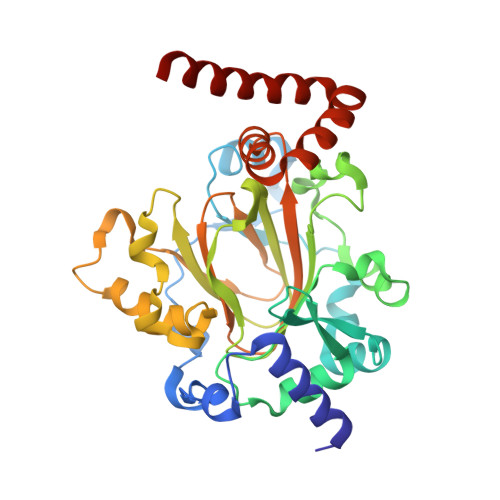JMJD6 cleaves MePCE to release positive transcription elongation factor b (P-TEFb) in higher eukaryotes.
Lee, S., Liu, H., Hill, R., Chen, C., Hong, X., Crawford, F., Kingsley, M., Zhang, Q., Liu, X., Chen, Z., Lengeling, A., Bernt, K.M., Marrack, P., Kappler, J., Zhou, Q., Li, C.Y., Xue, Y., Hansen, K., Zhang, G.(2020) Elife 9
- PubMed: 32048991
- DOI: https://doi.org/10.7554/eLife.53930
- Primary Citation of Related Structures:
6MEV - PubMed Abstract:
More than 30% of genes in higher eukaryotes are regulated by promoter-proximal pausing of RNA polymerase II (Pol II). Phosphorylation of Pol II CTD by positive transcription elongation factor b (P-TEFb) is a necessary precursor event that enables productive transcription elongation. The exact mechanism on how the sequestered P-TEFb is released from the 7SK snRNP complex and recruited to Pol II CTD remains unknown. In this report, we utilize mouse and human models to reveal methylphosphate capping enzyme (MePCE), a core component of the 7SK snRNP complex, as the cognate substrate for Jumonji domain-containing 6 (JMJD6)'s novel proteolytic function. Our evidences consist of a crystal structure of JMJD6 bound to methyl-arginine, enzymatic assays of JMJD6 cleaving MePCE in vivo and in vitro, binding assays, and downstream effects of Jmjd6 knockout and overexpression on Pol II CTD phosphorylation. We propose that JMJD6 assists bromodomain containing 4 (BRD4) to recruit P-TEFb to Pol II CTD by disrupting the 7SK snRNP complex.
- Department of Biomedical Research, National Jewish Health, Denver, United States.
Organizational Affiliation:



















